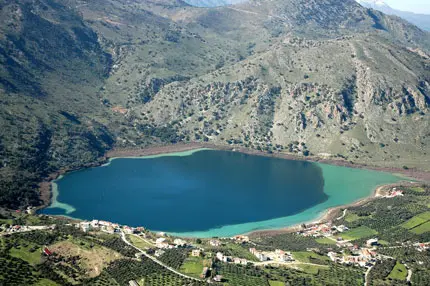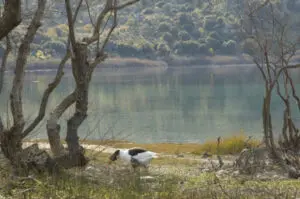Lake Kourna is the only natural freshwater lake of Crete. It is mentioned in antiquity by Stefanos the Byzantine under the name Korisia and it is said that there was an ancient temple in the area that was attributed to Korisia Athena] and seems to have been dedicated to Hippo or to Koris. Allegedly, these names gave rise to the older toponym Hippokorona which was later transliterated as Apokorona. The change of name of Korissia lake is placed during the period of the Arab rule in Crete, but the origin of the name is sometimes attributed to an Arabic word meaning lake or bather and sometimes as a paraphrase of the Greek word krounos.
Location and description
The lake is located on the borders of the municipality of Apokoronos in the east of the prefecture of Chania, close to the borders with the prefecture of Rethymno and at a distance of 2.5 km from the sea. It is approximately 4 km from the seaside settlement of Georgioupoli and 2.5 km from the homonymous settlement of Kournas. It is located on the northern fringes of the White Mountains. The exact elevation and dimensions of the lake change throughout the year, revealing its sandy shore in the summer months. The lake has a maximum length of 1087 meters and a maximum width of 880 meters. It has a maximum area of 579 acres, while the maximum depth of the lake is 22.5 meters. The surface of the lake is at an altitude of 20 meters above sea level. The lake is roughly pear-shaped with its tail ending in a man-made dam to control the flow of water, constructed in 1962 by the Department of Agriculture’s Watershed Improvement Service.
Biodiversity
The lake is placed in a depression created by karst subsidence. In the waters of the lake there are eels (anguilla anguilla), while it is home to rare for the island fish, the atherina (atherina boyeri) and the blenny (blennius fluviatilis). In recent years, the appearance of a foreign species of fish in the waters of the lake, the common goldfish (carassius auratus), has been observed, attributed to human intervention altering the ecological balance of the ecosystem. Another alien species is the mosquitofish (gambusia affinis), which was introduced to fight mosquitoes. Eels are the only ones that at a young age come to grow in the lake.
The geese of Kourna Lake
There are also reptiles such as terrapins (lacerta trilineata trilineata), horned snakes (telescopus fallax fallax) and a rare species of bicolor turtle (malaclemys terrapin). The avifauna of the lake includes common ducks, mallards (aythya nyroca), purple herons (ardea purpurea), egrets (egretta alba), water hens (gretta garzetta), netta rufina, copper hens (plegadis falcinellus) and cormorants (phalacrocorax carbo). The vegetation consists of endemic plants of Crete and the eastern Mediterranean, while the nearby heights consist of a sparse vegetation of holly and phrygana.
The lake is fed by two underground sources and the surface runoff, while the Mati or Amati source is visible in the receding waters observed in the lake during the summer months. The lake is an important stop for migratory birds, it has been included in the Natura 2000 network and is a protected Bird Fauna Protection Area. Riparian vegetation is in good condition on the east and south banks. The volume of water in the summer reaches 7.5 million cubic meters, while its waters end up in the Cretan Sea, through the river Delfina or Almyros with a length of 5 km.
The most important problems observed in the lake are the accumulation of touristic and residential activities, which affect the wetland with waste and sewage. The water quality remains suitable for swimming. The state of the lake is generally characterized as good but threatened with a deterioration of its environmental value. The incorrect construction of the dam which does not allow the controlled outflow, the pumping of the lake water for the irrigation of irrigated lands, for the water supply needs of the settlements and the deposits, have significantly changed the quantitative and bathymetric characteristics of the lake.
Surrounding area
The semi-mountainous and lowland area with the lake and streams is classified as a habitat of the European Corine program. The protection of the area from construction and tourist exploitation is characterized by the Department of Water Resources and Environment of the National Technical University of Athens as very urgent due to the tendency of degradation. In addition to the species found in the lake, more than 40 species of birds and several species of reptiles are found. In the Natura protection network, including Lake Kournas with the estuary and estuary of the Almyros River, more than 130 species of birds are recorded. Hotel development and hunting are the main threats. Another nearby Corine protection zone is the marshy and coastal area of the Delfinos stream and near the Asprouliani settlement. Its condition is characterized by the university department as good despite pollution from agricultural runoff and the construction of a hotel complex at the mouth of the stream. The protection priority is designated as capital.
The coastal eastern area of the municipality of Apokoronos from the entrance of the Souda bay to the Drapanos peninsula, the inland and the coastal area of Lake Kournas belong to a wider unit of Natura protection zone, with rich underground and surface water table, hydrophilic plants and strong biodiversity . Rare species, such as the euphorbia or the tree palm and the Cretan palm, the aquatic lemna or water lentil (Lemna minor) and the elm (Ulmus minor subsp. minor) which are found only in this area of Crete, the endangered kastanosaurus or silivouti ( podarcis erhardii) and the Caretta-Caretta sea turtle, endemic species of bat (Rhinolophus ferrumequinum and rhinolophus ferrum-equinum), possibly also the mole or small mole (Spalax leucodon). Other important species are the sand lily (pancratium maritimum) which loses over time the sandy coastal areas where it grows, the colchicum macrophyllum (colchicum macrophyllum) which is a protected and endemic plant of the Aegean, as well as the wild lettuce (Lactuca acanthifolia) and the turnip (Brassica cretica) found in addition to the Aegean and in Lebanon.


